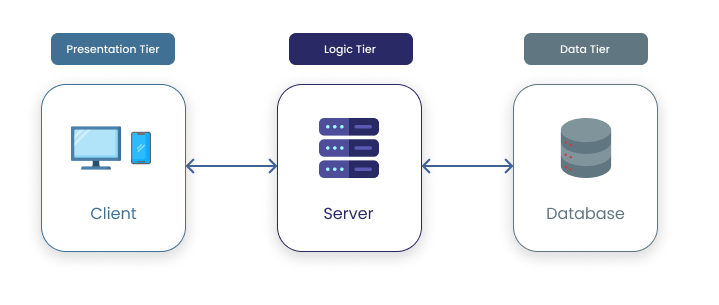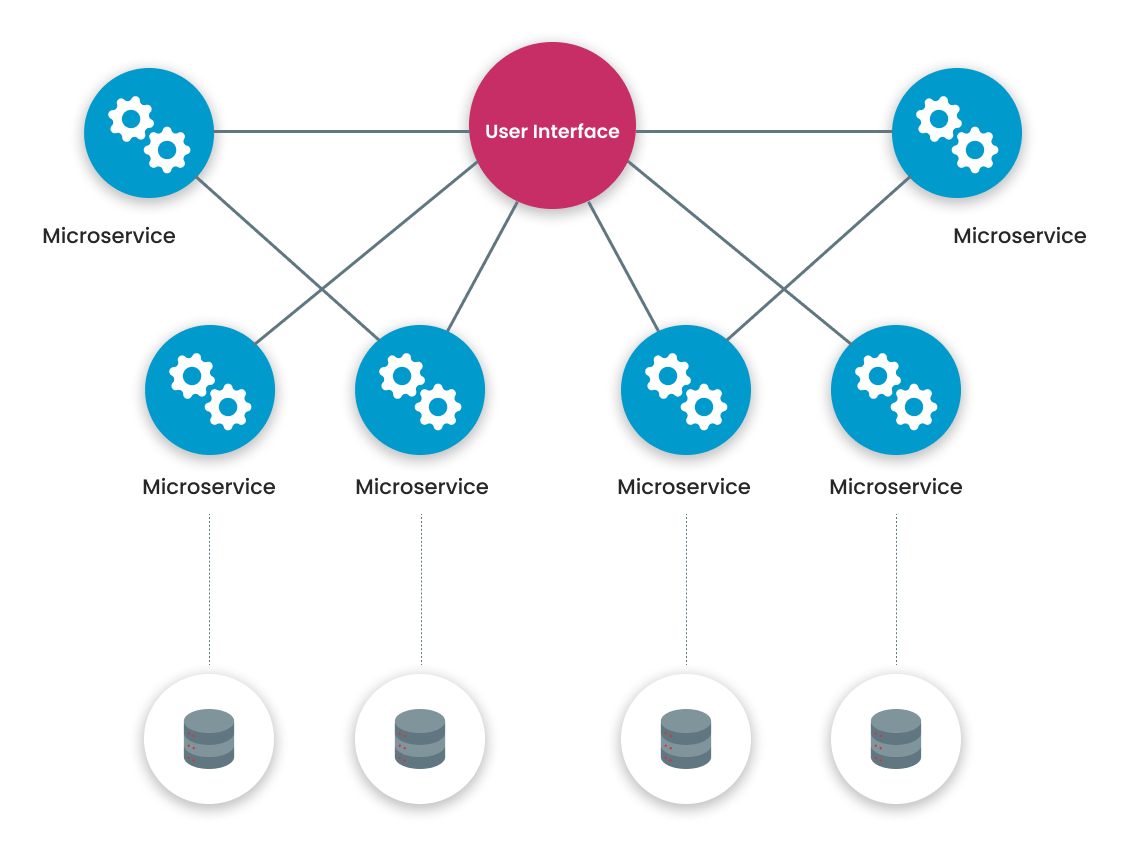Flash back
Over the last 25 years of modern IT, we saw the web technologies evolving from the basic static websites of Web 1.0 to the dynamic, user-driven marvels of Web 2.0, the mobile revolution, and the era of cloud computing. At the same time, technical architectures evolved from monoliths to serverless. We relentlessly spanned technical advancements, network and user interactivity improvements.
Post-COVID
We are now entering an era requiring rapid adaptation, resilience and cost-effective scaling. This is where Composable MACH comes into play. This article explores our history to better understand WHY Composable MACH may be relevant to our future.
Technical advancement – Brief Web History
In the ever-expanding universe of the internet, we’ve witnessed remarkable transformations over the years. From the rudimentary digital landscape of Web 1.0 to the interactive marvels of Web 2.0, the mobile revolution, and the advent of cloud computing, each era has brought about groundbreaking changes in technical advancement, network improvement, and user interactivity. Let’s take a journey through time, exploring the key milestones in these categories and understanding how they have paved the way for the future, including the exciting realm of Composable Architecture and allowed MACH to exist.
Web 1.0 (1990s – Early 2000s): Building the Foundations
Technical Advancements: During Web 1.0, the internet was in its infancy. Basic static websites were prevalent, and HTML ruled the digital landscape. The focus was on establishing an online presence, and technical advancements primarily revolved around creating simple web pages.
Network Improvement: Internet connectivity was slow and often limited to dial-up connections. This era marked the introduction of early broadband technologies, albeit with limited availability. The emphasis was on expanding the reach of the internet infrastructure.
Interactivity with Users: Web 1.0 was characterized by one-way communication. Users could view information presented on websites, but there was minimal interactivity. Websites served as digital brochures for businesses, lacking the dynamic engagement we experience today.
Web 2.0 (Mid-2000s – Present): Empowering User Interaction
Technical Advancements: Web 2.0 ushered in a new era of interactivity. Rich Internet Applications (RIAs) became possible with technologies like AJAX, enabling dynamic content and responsive interfaces. This period saw the rise of user-generated content, social media platforms, and advanced web applications.
Network Improvement: Broadband internet became more widespread, allowing for faster and more reliable connections. Internet protocols and data transfer methods improved, enhancing the overall efficiency of web interactions.
Interactivity with Users: User interaction became the focal point of Web 2.0. Social media platforms such as Facebook and YouTube emerged, enabling users to create, share, and discuss content collaboratively. Blogs, wikis, and forums became popular, fostering online communities and discussions.
Mobile Revolution (2000s – Present): Anytime, Anywhere Connectivity
Technical Advancements: Mobile technology advanced rapidly, leading to the development of smartphones. These devices incorporated touchscreens, mobile applications, and improved processing power, revolutionizing how we interact with digital content on the go.
Network Improvement: The rollout of 3G and 4G networks significantly enhanced mobile internet speeds and coverage. Mobile devices became increasingly connected, allowing users to access the internet from virtually anywhere.
Interactivity with Users: Mobile devices introduced a new level of interactivity. Mobile apps became a staple, offering personalized experiences and functionalities tailored to individual user needs. Location-based services and augmented reality apps further enriched user engagement.
Cloud Computing (2000s – Present): The Power of Virtualisation
Technical Advancements: Cloud computing brought virtualization to the forefront. Infrastructure as a Service (IaaS), Platform as a Service (PaaS), and Software as a Service (SaaS) models emerged, providing scalable, flexible, and on-demand computing resources over the internet.
Network Improvement: High-speed internet connectivity became essential for seamless cloud computing. Data centres and networks evolved to handle the increasing demand for cloud services. Fiber-optic networks and improved routing technologies optimised data transmission.
Interactivity with Users: Cloud computing transformed how users interacted with digital resources. Online collaboration tools, cloud storage services, and web-based applications became commonplace. Users could access their files, software, and data from any device with an internet connection.
The trajectory from Web 1.0 to the Cloud era reveals a consistent trend: a move towards more modular, dynamic, and user-centric digital experiences. Composable architecture stands as the next logical step in this journey, promising unparalleled flexibility and adaptability in our ever-evolving digital landscape.
A Brief History of Digital Systems
With technical advancement on the infrastructure layer. let’s draw parallel advancement with general Digital Architecture.
Architecture History
Monolithic Systems
In the earliest days of software, we had monolithic systems. A single codebase governed everything, from the user interface to business logic and data access. While this approach made deployment easy, it was inflexible. Changes to one part often required altering other parts, making scaling and maintenance challenging.
Tier Architecture
This model divided software into three layers: presentation, logic, and data. This separation allowed teams to work on different layers independently, offering better scalability than monolithic systems.
Microservices
A further evolution came with the introduction of microservices, where software was split into independent services that communicated over the network. This architecture offered even more flexibility and scalability but required robust network infrastructure and management.
Serverless and Function-as-a-Service (FaaS):
These paradigms further abstracted infrastructure concerns. Developers focused solely on writing functions, while the underlying platform managed everything from resource allocation to scaling.
Strong Link to Agility
Agility in the software world refers to the ability to adapt and respond quickly to changing conditions. Composable architecture, by its very nature, champions this agility:
- Quick Iteration: Since each module can be developed, tested, and deployed independently, teams can iterate rapidly.
2. Flexibility in Design: Organizations can mix and match components based on evolving requirements.
3. Efficient Resource Utilization: Resources can be allocated dynamically based on the demand of individual components, leading to cost savings.
4. Future-Proofing: As new technologies and modules emerge, they can be easily integrated without overhauling the entire system.
As we reflect on the evolution of the digital architecture, it’s clear that these advancements have also laid the groundwork for the future. Composable Architecture, with its focus on flexibility, scalability, and adaptability, stands at the forefront of this digital architecture.
What is Composable Architecture?
In its essence, composable architecture is about breaking down applications into modular, interchangeable, and reusable pieces. Each module, or “composable unit,” can be combined with others to create tailored applications. The advantage here is clear: rather than building from scratch or trying to customize monolithic applications, businesses can “compose” applications using pre-made modules at the image of Mr. Potato Head that can be customized to suits needs.
Features of Composable Architecture:
1. Modularity: Each component is self-contained, enabling independent deployment and scalability.
2. Interoperability: Components can easily interact with one another, regardless of where they are deployed.
3. Reusability: Components can be reused across multiple applications or even across multiple organizations.
4. Rapid Deployment: New solutions can be quickly composed using existing modules.
Benefit of Composable Architecture
The benefits of such an architecture include:
- Flexibility: Components can be added, removed, or replaced without disrupting the rest of the system, allowing for easy adaptation to the changing needs of a business.
- Reusability: Components can be designed to be reused across different contexts or applications, reducing development efforts and costs.
- Development Efficiency: By isolating functionalities in separate components, teams can work more independently and in parallel, thus reducing dependencies and conflicts.
- Simplified Maintenance: Updates can be made on individual components without the need for a complete system overhaul, simplifying maintenance and reducing the risks associated with changes.
- Scalability: A composable architecture can adapt to increasing workloads simply by adding new components or enhancing existing ones.
- Interoperability: Components designed to be interoperable can work with a variety of platforms and technologies, facilitating the integration of heterogeneous systems.
- Resilience: If one component fails, the rest of the system can often continue to function. Also, it’s easier to build redundant or high-availability systems.
- Cost Optimisation: By utilising standardised components, companies can reduce licensing costs and avoid vendor lock-in.
- Better Risk Management: Replacing or updating individual components can reduce the risk associated with introducing new technologies or relying on outdated systems.
- Customisation: Systems can be quickly tailored to meet specific customer needs or market demands without having to reinvent or develop new solutions from scratch.
Adopting a composable architecture requires careful planning and design to ensure that the interfaces between components are well-defined and that the overall system remains coherent and performant. It is particularly well-suited to cloud environments and agile development methodologies.
Composable Architecture emerged naturally with all the surrounding technical evolution such a Mobile connectivity and Cloud. It follows the society trends of Occidental World of ever more specialisation by allowing the very best for each use-case only when you need it (division of Labor)
In the same way cloud services enable businesses to pay only for the resources they use, Composable Architecture operates on a similar principle. MACH, being Microservices, API-first, Cloud-native, and Headless, naturally aligns with the evolution of Composable Architecture. Together, they represent a seamless progression towards more efficient, tailored, and cost-effective digital solutions.
MACH Architecture: The Modern Blueprint for Digital Evolution
Digital architecture has witnessed dramatic changes over the past few decades as we just described. As technology and business requirements evolved, so did the models and practices governing how software is designed and deployed. One of the latest trends in this continuous journey is the adoption of MACH architecture.
Introducing MACH Architecture
MACH stands for Microservices, API-first, Cloud-native, and Headless. It represents a set of design principles aimed at creating flexible, scalable, and future-proof digital platforms.
- Microservices:
– Principle: Decompose functionality into small, independent units that can be developed, deployed, and scaled individually.
– Benefit: Offers agility in development, ensures resilience, and allows teams to work in parallel without stepping on each other’s toes.
- API-first:
– Principle: Design APIs before developing the actual functionality, ensuring that systems can seamlessly talk to each other.
– Benefit: Ensures interoperability and flexibility. This forward-thinking approach means any component can be replaced without affecting the whole system.
- Cloud-native:
– Principle: Design applications to harness the power of cloud computing from the get-go.
– Benefit: Achieve scalability, resilience, and flexibility. It also allows for cost-effective scaling and makes use of managed services provided by cloud vendors.
- Headless:
– Principle: Separate the frontend (the “head”) from the backend functionality, often through APIs.
– Benefit: Offers unparalleled flexibility in delivering content or functionality across multiple platforms, devices, or channels without reworking backend logic.
Why MACH Matters?
In today’s digital age, businesses need to pivot quickly, scale on-demand, and deliver consistent multi-channel experiences. MACH architecture, by its very design, supports these needs:
– Flexibility: Replace, update, or scale any component without overhauling the entire system.
– Agility: Quickly iterate on features or adopt new technologies.
– Multi-channel Delivery: Cater to web, mobile, IoT, and other platforms seamlessly.
– Performance: Leverage cloud infrastructure for on-demand scaling and resilience.
Conclusion
The transition from monolithic systems to MACH underscores a broader industry shift towards agility, flexibility, and performance. As businesses navigate an ever-evolving digital landscape, MACH architecture emerges as a beacon, illuminating the path to sustained digital success.
MACH and Composable
As we navigate the intricate and ever-evolving landscape of technology, businesses face a paramount challenge: agility. The ability to pivot and adapt with ease is no longer a luxury but a necessity for survival and success. This is where the brilliance of Composable and MACH (Microservices-based, API-first, Cloud-native, and Headless) architectures shines through, revolutionising the way businesses approach their digital strategy.
The Symphony of Flexibility and Innovation
A Composable architecture, with its modular design, serves as a beacon of flexibility. It allows businesses to rapidly adjust their systems by integrating, replacing, or enhancing individual components without disrupting the entire IT ecosystem. This granular control empowers businesses to respond swiftly to market demands or internal process upgrades.
MACH architecture goes hand-in-hand with this composability, like a well-orchestrated symphony, each element (Microservices, API-first, Cloud-native, and Headless) plays its vital part:
– Microservices ensure that applications are broken down into small, independent pieces that work seamlessly together.
– API-first approach positions interoperability at the forefront, allowing for diverse applications to communicate fluidly.
– Cloud-native is the linchpin of scalability and resilience, offering robustness and a fail-safe environment.
– Headless architectures decouple the front-end presentation layer from the back-end logic, granting unparalleled creative freedom to craft user experiences without being tethered to back-end constraints.
The Concerto of Benefits
By adopting a Composable and MACH architecture, businesses orchestrate a concerto of benefits:
- Rapid Market Adaptation: The agility provided by these architectures means businesses can quickly launch new features, services, or pivot entire business models to meet market trends.
- Resilience: In an era where downtime is unforgivable, the inherent robustness of MACH and Composable systems ensures continuous operation, even if one component needs maintenance or updating.
- Innovation at Pace: Freed from the shackles of monolithic systems, developers can innovate at speed, delivering value to customers through continuous improvement and deployment.
- Cost-Effective Scaling: With Cloud-native technologies, scaling becomes a matter of strategic choice rather than a costly overhaul, optimising both performance and cost.
- Enhanced Customer Experience: Headless architectures allow for bespoke customer experiences across various touchpoints, essential in today’s omnichannel world.
Harmonising Business and Technology
As businesses strive to maintain a competitive edge, the amalgamation of Composable and MACH architectures is not just a technical decision; it’s a strategic realignment. It harmonises business objectives with technological capabilities, ensuring that the two move in concert towards a common goal: delivering exceptional value and experiences to customers.
Conclusion
In summary, the adoption of Composable and MACH architectures marks a pivotal moment for businesses seeking to thrive in the digital realm. This transformative journey signifies more than just a technical transition; it’s a strategic leap into an era of unprecedented agility, resilience, and customer-centricity. By seamlessly blending the modularity of Composable Architecture with the principles of MACH—Microservices, API-first, Cloud-native, and Headless—enterprises are empowered to swiftly adapt, innovate at scale, optimise costs, and elevate customer experiences.
This convergence of cutting-edge technology and strategic vision harmonises the aspirations of businesses with the capabilities of modern technology. It’s a symphony of adaptability and innovation, orchestrating a future where businesses not only survive but thrive. This journey is not without its challenges, but with the right guidance, such as the support that we offered at onepoint, businesses can confidently navigate this evolution. Together, Composable and MACH architectures redefine the digital landscape, setting the stage for businesses to compose their success story in the ever-evolving digital age.











